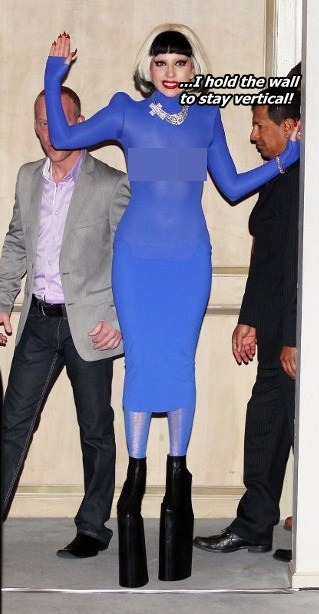A tall story: surgical leg lengthening
I wasn’t able to embed this video on my blog, but perhaps it’s just as well, because some of the footage is rather disturbing, especially if you’re a mite squeamish, like me. It shows the lengths (literally) to which some people will go to become taller, utilizing a procedure by which the leg bones are broken and rods placed in them that are then periodically manipulated so that new bone will grow in the break and cause an increase in height that can amount to several inches.
The surgery is both disturbing and ethically interesting. It was originally developed to help people with dwarfism and other serious height issues, and even in that arena it is controversial because it runs counter to the idea of acceptance and celebration of the condition, as well as causing some potential health problems:
The 7,400-member Little People of America says the risk of nerve and vascular damage in the years after the surgery is great. Besides, they say, a short stature makes them unique, and limb lengthening implies there’s something wrong with being “a little person.”
“Do you just go along with the crowd or teach people difference is OK?” said LPA activist Colleen Gioffreda. She, her husband, Jim, and their 2-year-old son, Connor, all were born with achondroplasia. “It scares me to think people want to become more and more the same,” she said.
Michael Ain, an orthopedic surgeon at Johns Hopkins Hospital, says premature arthritis is just one possible complication. “There’s an enormous amount of risk,” said Ain, himself a dwarf who decided against the surgery. “Nobody really knows what’s going to happen to them.”
Paley’s patients believe they know. One of them is Gillian Mueller, 26, of Columbia, Md., who has been living with longer limbs for 13 years.
“It’s one of the best decisions I’ve ever made,” Mueller said.
The procedure was developed in Russia about 50 years ago, and in dwarfs of the type with extremely short limbs it also makes the body proportions seem more normal. It can be started in childhood, when the results tend to be better, and the height gained can be profound: for example, from 4′ to 5′ 3″, if begun early enough. In dwarfs the procedure is covered by insurance, and it runs around $150,000 for multiple surgeries, which are only done in a few places in the world.
So, is this a cosmetic procedure or not, if done in childhood to a person born with this condition? It can change the person’s entire life, including the chances for a good job and the choices for a spouse. Typically the decision would be made by the child and/or his/her parents, and paid for by insurance. Should this be allowed? And would the answer be different if it were paid for out-of-pocket? Those who lack compassion for the situation might want to watch this slideshow. However, I’m not so sure a whole lot of families will want to avail themselves of a surgery that involves so much suffering and risk.
Then there are the non-dwarf but short adults with whom I began this post, who are now undergoing the surgery, too. In a way their decision should be even easier to support because they are grownups and they are all paying out-of-pocket (although of course their condition is less extreme). So the libertarian stance would be that they should be allowed to do whatever they wish, and that’s pretty much my point of view. But what of the surgeons? If you were an orthopedist specializing in this procedure for children born as dwarfs, what would you think if a man of 5’6″—the height of the guy featured in that first video—came to you and asked for help? He is getting a second procedure, as well, and believes his final height will be 6′ or above.
The article doesn’t say, but my guess is that among the adult candidates there would be more men than women, because men tend to find low stature more of a drawback than women do, and there is a lot of research to show they’re correct. But it’s a slippery slope, and no doubt many women would want it too, although they can avail themselves of 6-inch heels instead if they can manage to walk in them.
Here, for example, is the diminutive (5’1″) Lady Gaga with an extreme example:
And lest you think this is merely a modern-day Western obsession, take a look at the oiran geta, footwear traditionally worn in ancient Japan by women trained as a high-class prostitutes/entertainers:



My brother in law went through a sort-of reverse of this after he shattered both legs in a head-on car accident. Numerous surgeries on both legs (6+ each, legs were re-broken). He can walk, but he lost about 3 inches in height. Really not something to do voluntarily.
Overall, this is on par with other questionable elective cosmetic surgeries, such as reducing the size of ones little toe to fit into narrower, more fashionable shoes and having your, uh, lady bits tucked to appear younger. Ick! Be happy with who you are.
I remember seeing a story on a group of deaf people who rejected cochular (sp?) implants. They felt a sense of community in their deafness that they thought would be loss with hearing.
There was a Seinfeld episode involving a dwarf that was caught “heightening” by slipping things into his shoes. His fellow dwarves beat on him and , if they were female, refused to continue seeing him.
Ah yes, “The Stand In.”
“Kramer has got a job as a stand-in actor, in the series All My Children, along with his friend Mickey Abbott (Danny Woodburn), a “little person” who is offended by the term “midget”. Mickey, however, is worried to keep up his role as a rapidly-growing child. Kramer suggests Mickey use “lifts” to increase his height. Other “little” actors notice something different on Mickey as he plans to date Tammy, a little woman. Johnny Bigiano, another small actor, sets to find out what is going on with Mickey. When Johnny discovers the lifts, Mickey is ostracized by the other dwarf actors, including Tammy, and blames it all on Kramer.”
eeee-uuuuuew!
Butt the Gaga and oiran “footgear” almost make pointe shoes look comfy by comparison.
When eldest daughter was a toddler, we had her ankles surgically broken, rotated, pinned and her legs put in full casts in order to straighten her feet. She was born with spina bifida, and this surgery enabled her to walk with substantially less bracing (bracing only below the knee instead of all the way up to her waist).
It was in one sense an elective surgery, and one of the most difficult decisions I had to make, even though I knew it would dramatically enhance her mobility. I can’t imagine encouraging any similar invasive alteration for purely cosmetic reasons. And I don’t care how short you are; there’s no reason other than sheer vanity to use such surgery to change your 5’6″ height into 6′.
Ahh yes, platform shoes, I remember them well. Now if they’d just bring back the Ohio Players.
>>> “It scares me to think people want to become more and more the same,” she said.
There’s a huge difference between wanting to be “the same” and wanting to be less obviously noticeable when you don’t want to be noticed (or do, if you’re in a crowd… being one of the ‘little people’ in a crowd has to be a major bitch).
Being unusually short is a serious downcheck in a lot of “unwritten books”, including the one for attracting female mates. And oyu can claim that “ought not to be so”, but that’s the way it is and that’s the way it’s likely to stay.
I’m 5 feet 9 – which meant that in the US I was slightly on the short side for a man.
Then I moved to Israel – where I am solidly average, at least for my generation.
There most definitely was a difference in many social interactions.
But I can’t imagine going through this unless I was a lot closer to 5 feet tall and/or still unmarried…. and even then I’m not sure I would.
That 5 foot 6 guy? I’d tell him to live with it… and I hope he has another 85,000 dollars laying around when he and his future wife want to buy a house….